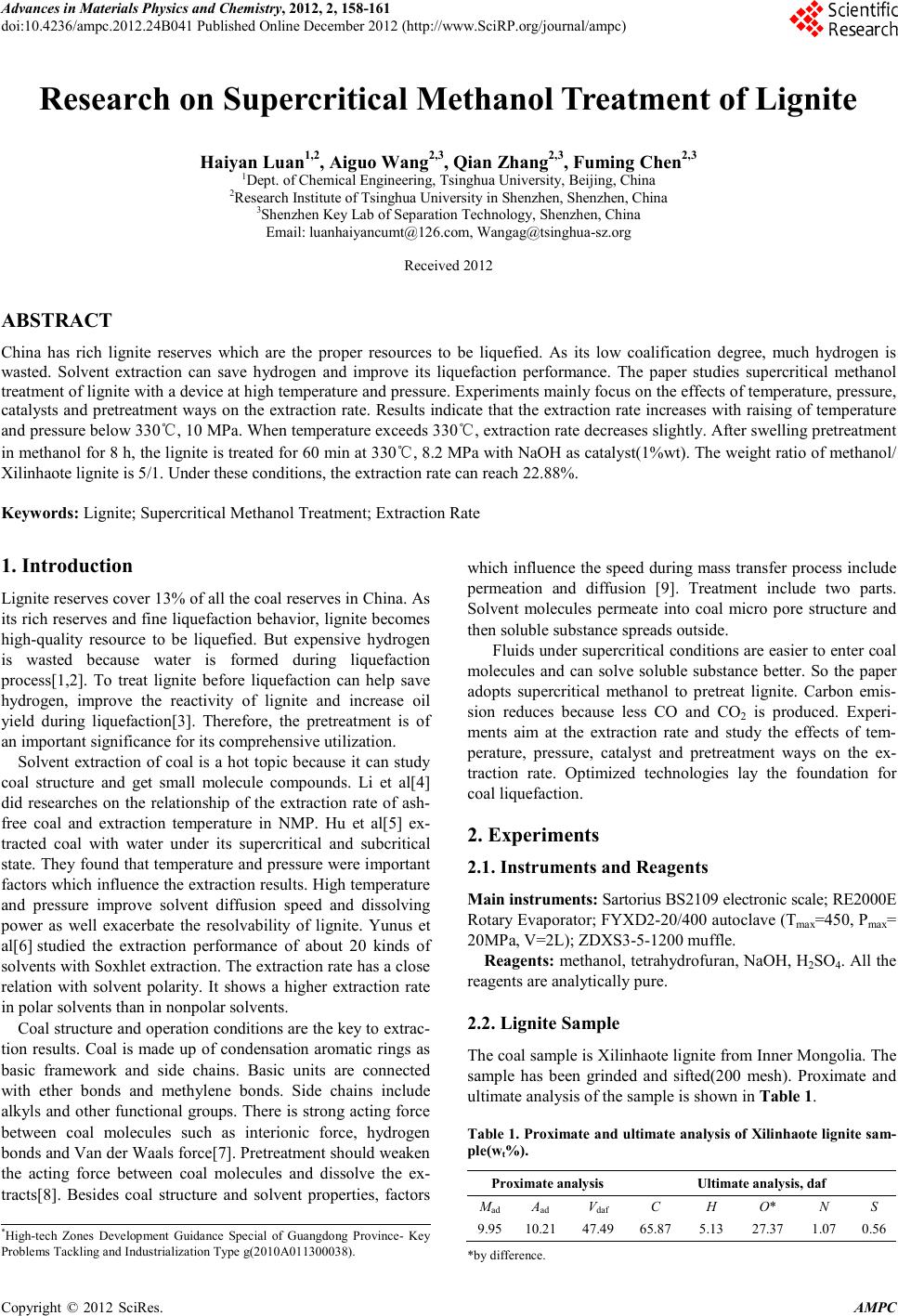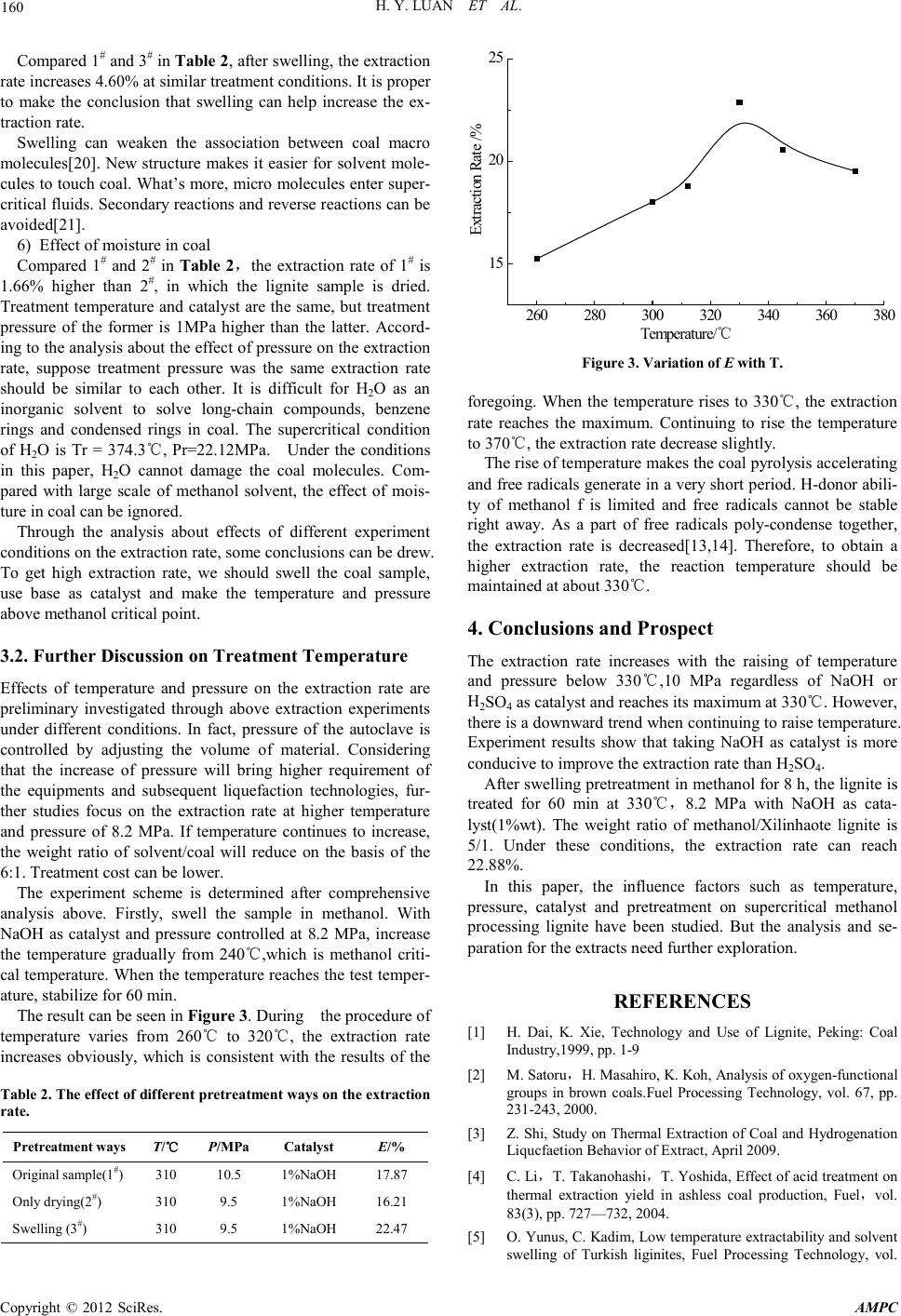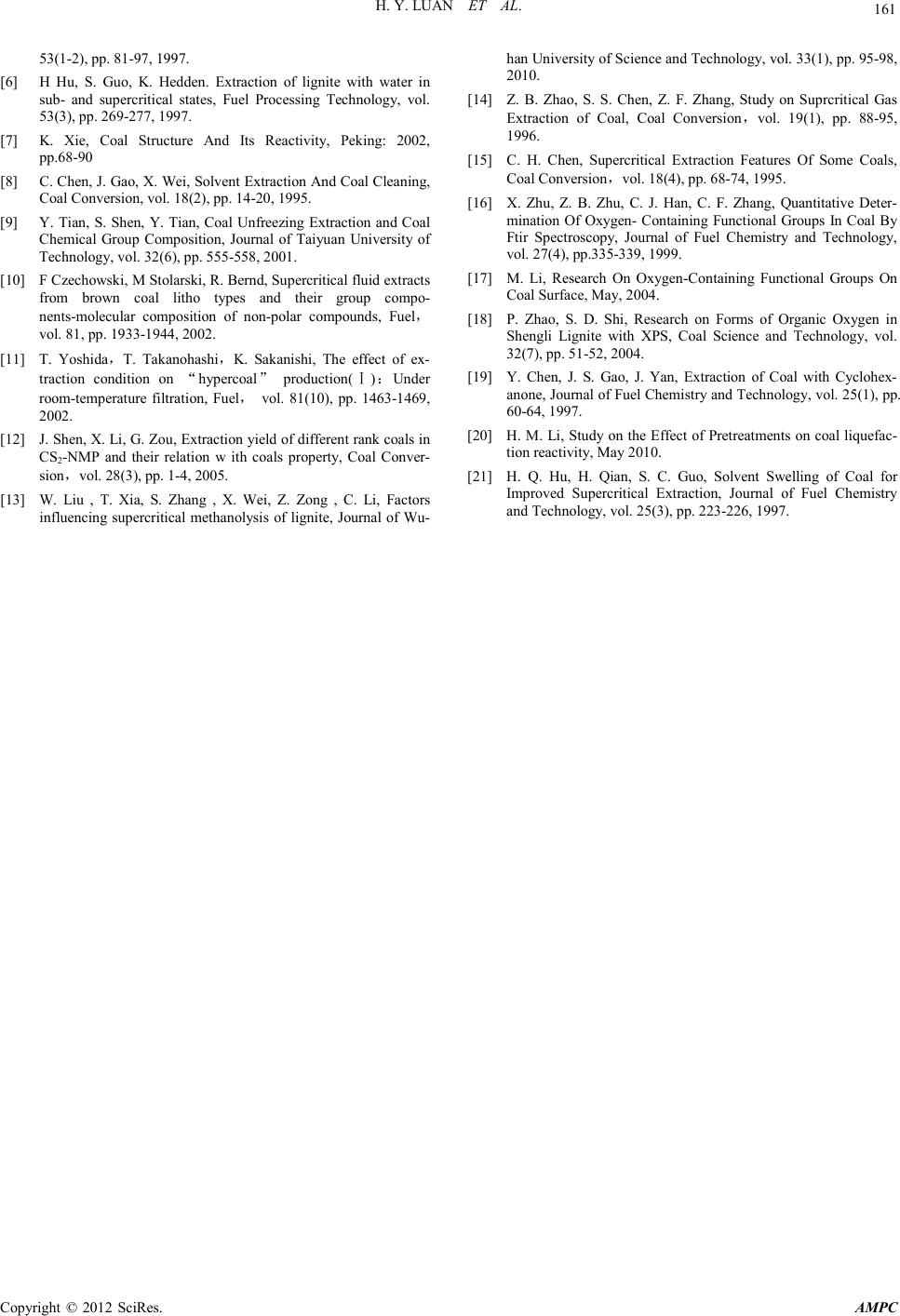Paper Menu >>
Journal Menu >>
 Advances in Ma terials Physics and Che mist ry, 2012, 2, 158-161 doi:10.4236/ampc.2012.24B041 Published Online December 2012 (htt p://www.SciRP.org/journal/ampc) Copyright © 2012 SciRes. AM PC Research on Supercritical Methanol Treatment of Lignite Haiyan Luan1,2, Aiguo Wang2,3, Qian Zhang2,3, Fuming Chen2,3 1Dept. of Chemical Engineering, Tsinghua Universi ty, Beijing, China 2Research Institute of Tsinghua University in Shenzhen, S he n z hen, Ch ina 3Shenzhen Key Lab of Separation Technology, Shenzhen, China Email: luanhaiyancumt@126.com, Wangag@tsinghua-sz.org Received 2012 ABSTRACT China has rich lignite reserves which are the proper resources to be liquefied. As its low coalification degree, much hydrogen is wasted. Solvent extraction can save hydrogen and improve its liquefaction performance. The paper studies supercritical methanol treat ment of li gnit e with a devi ce at high temperatu re an d pressu re. Experi ment s mainl y focus o n th e effects of te mperatu re, p ressu re, catalysts an d pretreatment ways on the extraction r ate. Results indicat e that the extracti on rate increases with raisi ng of temperatur e and pressure below 330℃, 10 MP a. Wh en temperatu re ex ceeds 33 0℃, extracti on rat e decr eases sli gh tl y. After s wellin g pr etreatment in methanol for 8 h, the lignite is treated for 60 min at 330℃, 8.2 MPa with NaOH as catal yst(1 %wt). The weight r atio o f methanol/ Xilinhaote lignite is 5/1. Under these conditions, the extraction rate can r each 22.88 %. Keywords: Lignite; Supercritical Methanol Treatment ; Extraction Rate 1. Introduction Lignite reser ves co v er 1 3% o f all th e co al reserves i n C hi na. As its rich reserves and fin e liquefaction behavior, lignite becomes high-quality resource to be liquefied. But expensive hydrogen is wasted because water is formed during liquefaction process[1,2]. To treat lignite before liquefaction can help save hydrogen, improve the reactivity of lignite and increase oil yield during liquefaction[3]. Therefore, the pretreatment is of an important significance for its comprehensive utilization. Solvent extraction of coal is a hot topic because it can study coal structure and get small molecule compounds. Li et al[4] did researches on the relationship of the extraction rate of ash- free coal and extraction temperature in NMP. Hu et al[5] ex- tracted coal with water under its supercritical and subcritical state. The y found th at temperature and pressure were important factors whi ch in fluence the extr action results. High temperature and pressure improve solvent diffusion speed and dissolving power as well exacerbate the resolvability of lignite. Yunus et al[6] studied the extraction performance of about 20 kinds of solvents with Soxhlet extraction. The extraction rate has a close relation with solvent polarity. It shows a higher extraction rate in polar solvents than in nonpolar solvents. Coal st ructure and operation co ndition s are the key to extrac- tion results. Coal is made up of condensation aromatic rings as basic framework and side chains. Basic units are connected with ether bonds and methylene bonds. Side chains include alkyls and other functional groups. There is strong acting force between coal molecules such as interionic force, hydrogen bond s and Van d er Waals force[ 7] . Pr etreat ment sh ou ld weaken the acting force between coal molecules and dissolve the ex- tracts[8]. Besides coal structure and solvent properties, factors which influence the speed during mass transfer process include permeation and diffusion [9]. Treatment include two parts. Solvent molecules permeate into coal micro pore structure and then soluble substance spreads outside. Fluids under sup ercritical cond itions are easier to en ter coal molecules and can solve soluble substance better. So the paper adopts supercritical methanol to pretreat lignite. Carbon emis- sion reduces because less CO and CO2 is produced. Experi- ments aim at the extraction rate and study the effects of tem- perature, pressure, catalyst and pretreatment ways on the ex- traction rate. Optimized technologies lay the foundation for coal li quefaction . 2. Experiments 2.1. Instruments and Reagen ts Ma in i n st r uments: Sartorius BS2109 electronic scale; RE2000E Rotary Evaporator; FYXD2-20/40 0 aut ocl ave (Tmax=450, Pmax= 20MPa, V=2L); ZDXS3-5-1200 muffle. Reagents: methanol, tetrahydrofuran, NaOH, H2SO4. All the reagents are analytically pure. 2.2. Lignite Sample The coal sample is Xilinhaote lignite from Inner Mongolia. The sample has been grinded and sifted(200 mesh). Proximate and ultimate analysis of the sample is shown in Table 1. Table 1. Proximate and ultimate analysis of Xilinhaote lignite sam- ple(wt%). Proximate analysis Ultimate analysis, daf Mad Aad Vdaf C H O* N S 9.95 10.21 47.49 65.87 5.13 27.37 1.07 0.56 *by difference. *High-tech Zones Development Guidance Special of Guangdong Province- Key Problems T ackling and I ndustr ialization Type g(2010A011300038).  H. Y. LU A N ET AL. Copyright © 2012 SciRes. A MPC 159 2.3. Experiment M e thods Mix 200 g coal sample, certain methanol and 2 g catalyst into slurry. After swelling for 8 hours, put it into the autoclave. Heat the mixture at rate o f 5 ℃/min and stir it at rate of 200 r/min. Pressure is controlled by the intrant volume of methanol. Treat at a constant temperature for a certain time. Turn on the tap to cold down the system. When the temperature is below 70 ℃,take out all the material in the autoclave. Separate the solid and liquid after treatment using vacuu m suction filtration. Filter residue is washed three times by methanol and tetrahy- drofuran. When it is dried, test its ash content and calculate the extraction rate. 2.4. Analysis Methods Define the mass of dry solid before and after treatment as M1, M2, ash content as A1,A2, extraction rate as E. Suppose the weight of ash will not change during the treatment process, so: 112 2 MA MA⋅= ⋅ (1) ( )() ( ) 112 2 11 11 1 M AMA EMA −− − =− (2) According to (1)(2): ( ) 21 21 100% 1 AA EAA − = × − (3) The ash content of the extracts is below 0.1% by the test. That is all the ash is still in the solid. It is feasible to calculate the extract ion r ate using the above ash balance method. 3. Results and Analysis 3.1. Effects of Different Treatment Conditions on Extraction Performance 1) Effect o f temperatur e on extraction p er fo r mance Take H2SO4 and NaOH as catalyst separately. Treat the lig- nite for 60 min at9.0±0.5 MPa. The weight ratio of methanol: Xilinhaote lignite is 5:1.Research the effect of temperature on extraction performance(T=260-320 ℃). The variation of E with T is shown in Figure 1. 250 260 270 280 290 300 310 320 330 5 10 15 20 25 E xtr ac tio n R a te / % Temp erature / ℃ ■, H2SO4 as catalyst; ▲, Na OH as catalyst Figure 1. The effect of temperature on E. As is shown in fig1,with the increase of tempera- ture(260-320 ℃) at certain pressure, E increases obviously no matter th e catalyst is s ou r or basic. At lo wer temperatu re, th at is near or above the critical temperature of methanol, H2SO4 is better than NaOH. When temperature surpasses 270℃, NaOH is better than H2SO4. With the rise of temperature, solvent viscosity decreases. Solven t molecules are easi er to enter macro molecule st ructure, leading dissociation of ether bonds. The dissociation speed increase with the increasing temperature. Alcohols provide active hydrogen, therefore free radicals and micro molecules can be stable[13,14]. The solubility of compounds in methanol increases. Hence the extraction rate increases with temper ature. 2) Effect o f pressure on extract ion performance Take H2SO4 and NaOH as catalyst separately. Treat the lig- nite for 60 min at 260℃. The weight ratio of methanol/Xilin- haote lignite is 5/1. Research the effect of pressure on extrac- tion performance(T=260-320℃). The variation of E with T is shown in Figure 2. As is shown in Figure 2, with the increase of pressure at certain temperature, E increases obviously no matter the cata- lyst is sour or basic. When the pressure surpasses 8.1 MPa, NaOH is better th an H2SO4. For supercritical fluids, the increase of pressure means in- crease of solubility. During supercritical treatment, fluids of high solubility makes free radicals move away from coal sub- jects. Secondary reactions are avoided. At the same time, high pressure can make fresh solvent permeate into coal molecules. The mass transfer speed is raised because of higher turbulivity. Hence th e ext raction rate increases with pressure. 3) Effect o f catalysts o n extracti on p erformance Acid and base can help damage some strong chemical bonds. Through 2.1.1 and 2.1.2, we can make the conclusion that NaOH is bet ter than H 2SO4 when pressure surpasses methanol critical pressure and temperature above 270 ℃. Oxygen exists in coal in the form of carboxyl, hydroxyl and other functional groups. Carboxyl and hydroxyl are acid groups[16-18]. Base can also enforce hydrolyzation of oxygen bonds and increase the content of hydroxyl[19]. Hence to choose base as catalyst is better fo r raising extraction rate. 4) Effect o f pretreatment ways on ext r action performance All the experiment samples above have been swelled in me- thanol for 8 h. Pretreatment will influence coal molecule struc- ture. The table below shows the effect of different pretreatment ways on t he extraction rate at similar temperature an d pressure. 2 4 6 810 0 5 10 15 20 E xtr ac tio n R a te / % Pressure / MPa ■, H2SO4 as catalyst; ▲, NaOH as catalyst Figure 2. The effect of p ressure on E. 5) Swelling  H. Y. LU A N ET AL. Copyright © 2012 SciRes. A MPC 160 Compared 1# and 3# in Table 2, after swelling, the extraction rate incr eases 4 .60% at similar t reatmen t co ndi tion s. It is p roper to make the conclusion that swelling can help increase the ex- traction rate. Swelling can weaken the association between coal macro molecules[ 20]. New stru cture makes it e asier for solven t mole- cules to touch coal. What’s more, micro molecules enter super- critical fluids. Secon dary reacti ons and reverse react ion s can be avoided[21] . 6) Effect of moisture in coal Compared 1# and 2# in Table 2,the extraction rate of 1# is 1.66% higher than 2#, in which the lignite sample is dried. Treatment temperature and catalyst are th e same, but t reatment pressure of the former is 1MPa higher than the latter. Accord- ing to the analysis about the effect of pressure o n the extr action rate, suppose treatment pressure was the same extraction rate should be similar to each other. It is difficult for H2O as an inorganic solvent to solve long-chain compounds, benzene rings and condensed rings in coal. The supercritical condition of H2O is Tr = 374.3℃, Pr=22.12MPa. Under the conditions in this paper, H2O cannot damage the coal molecules. Com- pared with large scale of methanol solvent, the effect of mois- ture in coal can be ignored. Through the analysis about effects of different experiment conditions on the extractio n rate, some conclu si on s can be drew. To get high extraction rate, we should swell the coal sample, use base as catalyst and make the temperature and pressure above methanol critical point. 3.2. Further Discussion on Treatment Temperature Effects of temperature and pressure on the extraction rate are preliminary investigated through above extraction experiments under different conditions. In fact, pressure of the autoclave is controlled by adjusting the volume of material. Considering that the increase of pressure will bring higher requirement of the equipments and subsequent liquefaction technologies, fur- ther studies focus on the extraction rate at higher temperature and pressure of 8.2 MPa. If temperature continues to increase, the weight ratio of solvent/coal will reduce on the basis of the 6:1 . Treatment cost can be lower. The experiment scheme is determined after comprehensive analysis above. Firstly, swell the sample in methanol. With NaOH as catalyst and pressure controlled at 8.2 MPa, increase the temperature gradually from 240℃,which is methanol criti- cal temperat ure. Wh en the tempe rature reaches the test te mper- ature, stabilize for 60 min. The result can be s een in Figure 3. During the procedure of temperature varies from 260℃ to 320℃, the extraction rate increases obviously, which is consistent with the results of the Table 2. The effect of different pretreatment ways on the extraction rate. Pret r eatment way s T/ ℃ P/MPa Catalyst E/% Original sample(1#) 310 10.5 1%NaOH 17.87 Only drying(2#) 310 9 .5 1%NaOH 16.21 Swelling (3#) 310 9 .5 1%NaOH 22.47 260 280 300 320 340 360 380 15 20 25 E x trac tio n R a te /% Temperat ure/ ℃ Figure 3. Variation of E with T. foregoing. When the temperature rises to 330℃, the extraction rate reaches the maximum. Continuing to rise the temperature to 370℃, the extraction rate decrease slightly. The rise of te mperatu re make s th e coal pyrol ysis ac celerating and free rad icals generate in a very sho rt period . H-donor abili- ty of methanol f is limited and free radicals cannot be stable right away. As a part of free radicals poly-condense together, the extraction rate is decreased[13,14]. Therefore, to obtain a higher extraction rate, the reaction temperature should be maintai ned at about 330℃. 4. Conclus ion s and Prospect The extraction rate increases with the raising of temperature and pressure below 330℃,10 MPa regardless of NaOH or H2SO4 as catalyst and reaches its maximu m at 3 30℃. However, there is a downward trend when continuing to raise temperature. Experiment results show that taking NaOH as catalyst is more condu cive to improve the extr action rate than H 2SO4. After swelling pretreatment in methanol for 8 h, the lignite is treated for 60 min at 330℃,8.2 MPa with NaOH as cata- lyst(1%wt). The weight ratio of methanol/Xilinhaote lignite is 5/1. Under these conditions, the extraction rate can reach 22.88%. In this paper, the influence factors such as temperature, pressure, catalyst and pretreatment on supercritical methanol processing lignite have been studied. But the analysis and se- paration for th e ext r acts need fu r ther explorati on. REFERENCES [1] H. Dai, K. Xie, Technology and Use of Lignite, Peking: Coal Indus try,1 9 9 9, p p. 1-9 [2] M. Satoru,H. Masah ir o, K. Koh, Ana lysis of ox ygen-functional groups in brown coals.Fuel Processing Technology, vol. 67, pp. 231-243, 2000. [3] Z. Sh i, Study on Thermal Ext racti on of Coa l and Hydrogen ation Liqucf aetion Behavior of Extract, April 2009. [4] C . Li ,T. Takanohashi,T. Yoshida , Effect of acid treat ment on thermal extraction yield in ashless coal production, Fuel,vol. 83(3), pp. 7 27 —732, 2004. [5] O. Yunus, C. Ka dim, Low t empera ture extr act abilit y and solven t swelling of Turkish liginites, Fuel Processing Technology, vol.  H. Y. LU A N ET AL. Copyright © 2012 SciRes. A MPC 161 53(1-2), pp. 81-97, 199 7. [6] H Hu, S. Guo, K. Hedden. Extraction of lignite with water in sub- and supercritical states, Fuel Processing Technology, vol. 53(3), pp. 2 69-277, 1997. [7] K. Xie, Coal Structure And Its Reactivity, Peking: 2002, pp.68-90 [8] C. Chen, J. Gao, X. Wei, Solvent Extraction And Coal Cleaning, Coal C onversion, vol. 18(2), pp. 14-20, 1995. [9] Y. Tian, S. Shen, Y. Tian, Coal Unfreezing Extraction and Coal Chemical Group Composition, Journal of Taiyuan University of Te c hno logy, vol. 32(6), pp. 55 5-558, 2001. [10] F Czechowski, M Stolarski, R. Bernd, Supercritical fluid extracts from brown coal litho types and their group compo- nents-molecular composition of non-polar compounds, Fuel, vol. 81, pp. 1933-1944, 2002. [11] T. Yoshida,T. Takanohashi,K. Sakanishi, The effect of ex- traction condition on “hypercoal” production(Ⅰ):Under room-temperature filtration, Fuel, vol. 81(10), pp. 1463-1469, 2002. [12] J. Shen, X. Li, G. Zou, Extraction yield of di fferent rank coals in CS2-NMP and their relation w ith coals property, Coal Conver- sion,vol. 28(3), pp. 1-4, 2005. [13] W. Liu , T. Xia, S. Zhang , X. Wei, Z. Zong , C. Li, Factors influencing supercritical methanolysis of lignite, Journal of Wu- han University of Science and Technology, vol. 33(1), pp. 95-98, 2010. [14] Z. B. Zhao, S. S. Chen, Z. F. Zhang, Study on Suprcritical Gas Extraction of Coal, Coal Conversion,vol. 19(1), pp. 88-95, 1996. [15] C. H. Chen, Supercritical Extraction Features Of Some Coals, Coal C onversion,vol. 18(4), pp. 68-74, 1995. [16] X. Zhu, Z. B. Zhu, C. J. Han, C. F. Zhang, Quantitative Deter- mination Of Oxygen- Containing Functional Groups In Coal By Ftir Spectroscopy, Journal of Fuel Chemistry and Technology, vol. 27(4), pp.335-339, 1999. [17] M. Li, Research On Oxygen-Containing Functional Groups On Coal Surface, May, 2004. [18] P. Zhao, S. D. Shi, Research on Forms of Organic Oxygen in Shengli Lignite with XPS, Coal Science and Technology, vol. 32(7), pp. 5 1-52, 2004. [19] Y. Chen, J. S. Gao, J. Yan, Extraction of Coal with Cyclohex- anone, Journal of Fuel Chemistry and Technology, vol. 25(1), pp. 60-64, 1997. [20] H. M. Li, Study on the Effect of Pretreatments on coal liquefac- tion rea ctivi ty, May 2010. [21] H. Q. Hu, H. Qian, S. C. Guo, Solvent Swelling of Coal for Improved Supercritical Extraction, Journal of Fuel Chemistry and Technology, vol. 25(3), pp. 223-226, 1997. |

